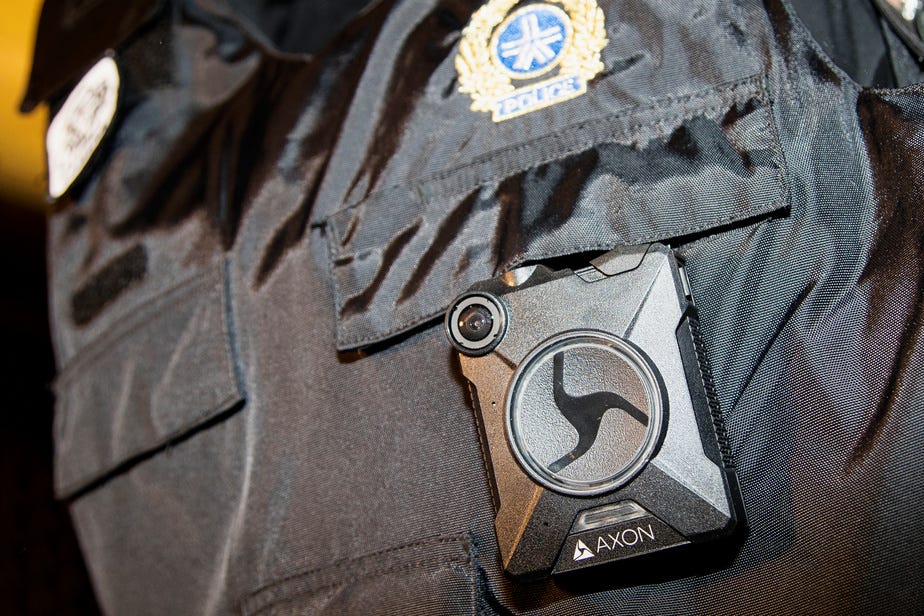Body cameras are not a solution
The history of police body cameras tells a different story than the marketing campaign
[This is an English version of a text published in Le Devoir, October 10, 2025.]
The events of the last few weeks have returned to the public debate a police technology, body cameras, that is supported by groups with quite different objectives. In early September, the Fraternité des policiers et policières de Montréal renewed its longstanding demand for its members to be outfitted with cameras, claiming the technology decreases “the level of aggressivity” of citizens toward the police. Two weeks later, the police killing of Nooran Rezayi in Longueuil, an unarmed 15 year-old, led some community members to demand the introduction of body cameras, claiming they would reduce police aggressivity and hold police accountable.
It’s an odd juxtaposition: a group devoted to the defence of police officers, especially those accused of violent acts, calling for the same policy change as citizens hoping to pierce police impunity. Such oddities, however, have characterized the debate about body cameras for over a decade, and have much to do with the development and marketing of the technology itself.
A technology of violence becomes a “reform”
The history and politics of body cameras is traced in a new book by the esteemed civil rights lawyer Alec Karakatsanis, Le caméra d’intervention. As Karakatsanis shows, body cameras were brought to market in the late 2000s by the technology company Taser, best known for the eponymous less-lethal weapon. In the early years, Taser (now known as Axon) and its competitors marketed the technology to police forces and governments as a way to film and more efficiently prosecute citizens. The cameras, attached to the chest of police officers, would provide mountains of video evidence of minor crimes in process, leading to more plea deals and higher conviction rates. Combined with facial recognition software, the video recordings would also improve the surveillance activities of police, especially during protests.
The marketing of body cameras changed radically, however, after the police killing of Michael Brown in Ferguson in 2014 and the wave of protests that followed. As Karakatsanis explains, Taser and its competitors saw an opportunity to expand sales of body cameras by claiming they would reduce police violence and hold police accountable. The cameras, the companies now explained, would provide video evidence of police actions and enable lawyers to prosecute them.
The new marketing strategy was incredibly successful. Taser’s sales of the cameras increased 668% between 2014 and 2018, as police forces and governments looked for easy ways to quell protests and show they were taking police violence seriously.
As companies continued to market the cameras as a police reform, evidence of their actual effects began to emerge. Reviewing over a decade of research, Karakatsanis makes things clear: cameras do not reduce police violence or help to hold police accountable. Police killings have only increased since 2014 and criminal convictions of police officers remain extremely rare. Consistent with their original purpose, he explains, camera footage “is almost never used against police officers.” It is overwhelmingly used against citizens, including victims of police violence and their communities.
A solution in search of a problem
The history of body cameras in Montreal dovetails with Karakatsanis’s account. In 2017, as the cameras were surging in popularity, the Montreal police launched a pilot project in which police officers wore body cameras for 12 months. At the end of this period, the merits of a permanent introduction of cameras was evaluated on the basis of the results of the pilot and a review of research on the subject.
The evaluation reached the same conclusions as Karakatsanis’s book: the use of force by police was basically unchanged (it increased modestly), while the introduction of cameras would require an enormous expansion of police spending and personnel: at least 200 people would need to be hired by the police to manage and analyze video recordings.
While the Montreal police and the municipal administration decided against cameras, the police brotherhoods (“unions”) became their primary proponents. In the Quebec government’s 2020 consultation on policing, the three major police fraternities called for the introduction of body cameras – for reasons that made perfect sense for them. The cameras would create more jobs for aspiring police officers while giving police services a valuable public relations tool: the ability to combat the videos of police interactions recorded by citizens and circulated on social media with their own recordings.
The lobbying of the fraternities had led to a strange situation in Montreal. The opposition party, Ensemble Montréal, has taken up the fraternities demand, but falsely described the cameras as a police reform. In a 2021 motion introduced to city council, the party claimed research in the United States showed the cameras significantly reduced police violence and that they would help to “combat racial profiling in Montreal.” Projet Montréal, while initially refuting its opponent’s rationale, eventually changed its position and is promising in the present election campaign to introduce body cameras on the vague promise they will renforce “the accountability” of the police force.
It is a bizarre history, then, that has led us to the present situation: a situation in which the Montreal Fraternité and some citizens are calling for body cameras for the exact opposite reasons. Citizens can be forgiven for believing the false promises of body cameras, which have been heavily marketed by their manufacturers since 2014. But it is astonishing and unconscionable to see two political parties promising the cameras will prevent events like the killing of Nooran, when they know this to be false.


